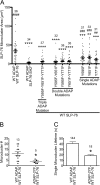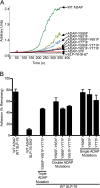Multipoint binding of the SLP-76 SH2 domain to ADAP is critical for oligomerization of SLP-76 signaling complexes in stimulated T cells
- PMID: 23979596
- PMCID: PMC3811887
- DOI: 10.1128/MCB.00410-13
Multipoint binding of the SLP-76 SH2 domain to ADAP is critical for oligomerization of SLP-76 signaling complexes in stimulated T cells
Abstract
The adapter molecules SLP-76 and LAT play central roles in T cell activation by recruiting enzymes and other adapters into multiprotein complexes that coordinate highly regulated signal transduction pathways. While many of the associated proteins have been characterized, less is known concerning the mechanisms of assembly for these dynamic and potentially heterogeneous signaling complexes. Following T cell receptor (TCR) stimulation, SLP-76 is found in structures called microclusters, which contain many signaling complexes. Previous studies showed that a mutation to the SLP-76 C-terminal SH2 domain nearly abolished SLP-76 microclusters, suggesting that the SH2 domain facilitates incorporation of signaling complexes into microclusters. S. C. Bunnell, A. L. Singer, D. I. Hong, B. H. Jacque, M. S. Jordan, M. C. Seminario, V. A. Barr, G. A. Koretzky, and L. E. Samelson, Mol. Cell. Biol., 26:7155-7166, 2006). Using biophysical methods, we demonstrate that the adapter, ADAP, contains three binding sites for SLP-76, and that multipoint binding to ADAP fragments oligomerizes the SLP-76 SH2 domain in vitro. These results were complemented with confocal imaging and functional studies of cells expressing ADAP with various mutations. Our results demonstrate that all three binding sites are critical for SLP-76 microcluster assembly, but any combination of two sites will partially induce microclusters. These data support a model whereby multipoint binding of SLP-76 to ADAP facilitates the assembly of SLP-76 microclusters. This model has implications for the regulation of SLP-76 and LAT microclusters and, as a result, T cell signaling.
Figures







Similar articles
-
ADAP is an upstream regulator that precedes SLP-76 at sites of TCR engagement and stabilizes signaling microclusters.J Cell Sci. 2018 Nov 8;131(21):jcs215517. doi: 10.1242/jcs.215517. J Cell Sci. 2018. PMID: 30305305 Free PMC article.
-
SH2 domain containing leukocyte phosphoprotein of 76-kDa (SLP-76) feedback regulation of ZAP-70 microclustering.Proc Natl Acad Sci U S A. 2010 Jun 1;107(22):10166-71. doi: 10.1073/pnas.0909112107. Epub 2010 May 13. Proc Natl Acad Sci U S A. 2010. PMID: 20534575 Free PMC article.
-
The SLP-76 Src homology 2 domain is required for T cell development and activation.J Immunol. 2011 Nov 1;187(9):4459-66. doi: 10.4049/jimmunol.0903379. Epub 2011 Sep 26. J Immunol. 2011. PMID: 21949020 Free PMC article.
-
Endocytic events in TCR signaling: focus on adapters in microclusters.Immunol Rev. 2009 Nov;232(1):84-98. doi: 10.1111/j.1600-065X.2009.00840.x. Immunol Rev. 2009. PMID: 19909358 Free PMC article. Review.
-
T cell activation at the immunological synapse: vesicles emerge for LATer signaling.Sci Signal. 2010 May 11;3(121):pe16. doi: 10.1126/scisignal.3121pe16. Sci Signal. 2010. PMID: 20460646 Review.
Cited by
-
Signaling in Effector Lymphocytes: Insights toward Safer Immunotherapy.Front Immunol. 2016 May 12;7:176. doi: 10.3389/fimmu.2016.00176. eCollection 2016. Front Immunol. 2016. PMID: 27242783 Free PMC article. Review.
-
Intracellular signalling pathways: targets to reverse immunosenescence.Clin Exp Immunol. 2017 Jan;187(1):35-43. doi: 10.1111/cei.12836. Epub 2016 Aug 3. Clin Exp Immunol. 2017. PMID: 27364690 Free PMC article. Review.
-
Systems-level conservation of the proximal TCR signaling network of mice and humans.J Exp Med. 2022 Feb 7;219(2):e20211295. doi: 10.1084/jem.20211295. Epub 2022 Jan 21. J Exp Med. 2022. PMID: 35061003 Free PMC article.
-
Integrative biology of T cell activation.Nat Immunol. 2014 Sep;15(9):790-7. doi: 10.1038/ni.2959. Nat Immunol. 2014. PMID: 25137453 Review.
-
Development of nanoscale structure in LAT-based signaling complexes.J Cell Sci. 2016 Dec 15;129(24):4548-4562. doi: 10.1242/jcs.194886. Epub 2016 Nov 10. J Cell Sci. 2016. PMID: 27875277 Free PMC article.
References
-
- Sangani D, Venien-Bryan C, Harder T. 2009. Phosphotyrosine-dependent in vitro reconstitution of recombinant LAT-nucleated multiprotein signalling complexes on liposomes. Mol. Membr. Biol. 26:159–170 - PubMed
-
- Houtman JC, Higashimoto Y, Dimasi N, Cho S, Yamaguchi H, Bowden B, Regan C, Malchiodi EL, Mariuzza R, Schuck P, Appella E, Samelson LE. 2004. Binding specificity of multiprotein signaling complexes is determined by both cooperative interactions and affinity preferences. Biochemistry 43:4170–4178 - PubMed
Publication types
MeSH terms
Substances
Grants and funding
LinkOut - more resources
Full Text Sources
Other Literature Sources
Molecular Biology Databases
Research Materials
